|
|
|
|
|
2005 JLab News Release
|
||||||
Targeting Quarks Inside the ProtonDecember 6, 2005Scattering Experiments To study the particles and the forces that build our universe, physicists must probe deep inside the nucleus - the very heart of matter. Since 1909, scattering experiments have allowed physicists to plumb these depths. In a scattering experiment, particles are hurled at the nucleus. If one of these projectiles strikes the nucleus, it's scattered, or thrown off its original track. This is the same thing that happens in a game of billiards when a cue ball hits another ball, and one or both balls go off in different directions at different speeds from before. It's important to note that while the billiard ball analogy helps us to visualize what happens, in the funky world of quantum mechanics, particles never actually collide. Instead, they exchange other particles. This exchange causes the change in the direction and speed of the projectile and the target particle that we ultimately see. A New View of Scattering Reveals Clues to Quark Structure Scattering experiments have revealed that protons and neutrons each contain three of the smallest building blocks of ordinary matter — quarks. Scattering experiments are also allowing physicists to investigate quarks. For instance, one recent experiment is shedding light on a previously unexplored area of the quark structure of the proton. The experiment combines two different views of the proton. One view is determined by the size of the projectile, and the other is set by the angle at which the projectile is scattered. Projectile Size and Scattering Angle The size of the projectile acts as a kind of lens. Larger projectiles probe larger objects. For instance, in probing proton structure, a larger projectile would provide a glimpse of the whole proton. Smaller projectiles probe smaller objects. In the case of the proton, smaller projectiles probe the quarks inside. In this way, scientists can focus in on different aspects of the proton by changing the size of the projectile. 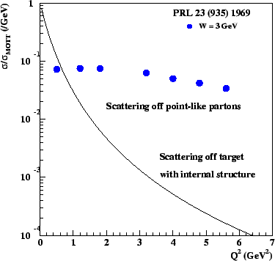
In 1969, physicists from the Massachusetts Institute of Technology (MIT) and the Stanford Linear Accelerator Center (SLAC) published the results of scattering electrons from protons. The researchers found that the probability that the electron would be deflected was much larger than expected if the projectile were scattering off a target with matter distributed uniformly inside. This probability is called the cross section, and the fact that it is relatively constant showed that the electrons were interacting with smaller particles inside the proton. Hence, the experiment found that there are constituents inside the proton -- quarks and gluons -- which are also called partons. This experiment was recognized with the Nobel Prize in Physics in 1990. If Jefferson Lab uses electrons as projectiles, how can you change the size of the projectiles? To interact with protons in a target, the electrons emit "virtual photons." Virtual photons are different from real photons in that they can have mass. By varying the virtual photons' mass, these virtual photons become "projectiles of varying size." The experiment can be interpreted as the scattering of photons of adjustable mass off a target proton. It gets even weirder. Due to the funky rules of quantum mechanics, these virtual photons may fluctuate into different particles before they strike a proton. Hence, a virtual photon may become a two-quark meson. This meson may provide information about the proton, but for information about the quarks inside, experimenters need virtual photons that have not changed into other particles. The angle at which the projectile is scattered identifies how the projectile interacted with the proton and its constituents. In a glancing blow, where the projectile's course is barely altered, very little interaction occurs. However, if the projectile's course is radically altered, then the projectile has interacted with and been changed by the proton's constituents. Therefore, the scattering angle may reveal information about the whole proton, in the case of the glancing blow, or the quarks and gluons inside the proton, in the case of the radical collision. Two Views Yield a New Picture Physicists at Jefferson Lab have succeeded in combining these two views for the first time, thanks to the unique CEBAF electron beam and Hall B's CLAS detector package. These illustrations show how combining these two probes provide physicists with much more information about protons and their quarks. In each "collision," the projectile interacts with the target proton by exchanging a particle. 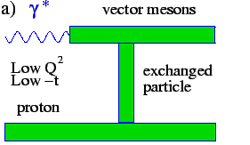
In this view, a large virtual photon has become a two-quark meson which has struck the proton in a glancing blow. This type of collision reveals only information about the meson and proton and nothing about the quarks inside the two particles. 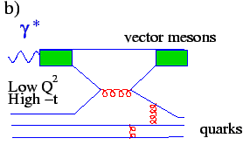
Here, a large virtual photon has become a two-quark meson which has struck the proton in a radical collision. This reveals information about the meson and its interaction with the quarks inside the proton. 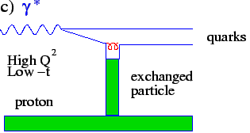
In the third example, a small virtual photon has struck the proton in a glancing blow. This type of collision reveals information about the virtual photon and the exchanged particle, but no information is revealed about the quarks inside the proton. 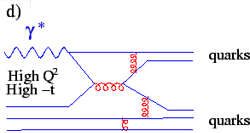
Lastly, a small virtual photon has struck the proton in a radical collision. This reveals information about the virtual photon and the quarks inside the proton. Combining information from these two probes is giving physicists a new view of the proton and how its building blocks interact - helping them understand the relation between the world of composite particles such as protons and neutrons and the world of the elementary quarks and gluons. These two views offer a new opportunity for physicists to unravel the secrets of the very basic building blocks of everyday matter. Authors: Jean-Marc Laget and Elton Smith with Kandice Carter For a more technical view of this experiment, visit: http://www.jlab.org/Hall-B/public/hight_vmweb.html For more general level information on this experiment, visit: http://www.jlab.org/news/releases/2004/04thesis.html Thomas Jefferson National Accelerator Facility’s (Jefferson Lab’s) basic mission is to provide forefront scientific facilities, opportunities and leadership essential for discovering the fundamental structure of nuclear matter; to partner in industry to apply its advanced technology; and to serve the nation and its communities through education and public outreach. Jefferson Lab, located at 12000 Jefferson Avenue, is a Department of Energy Office of Science research facility managed by the Southeastern Universities Research Association. content by Public Affairs maintained by webmaster@jlab.org updated December 6, 2005 |